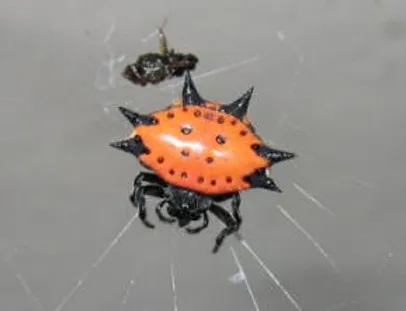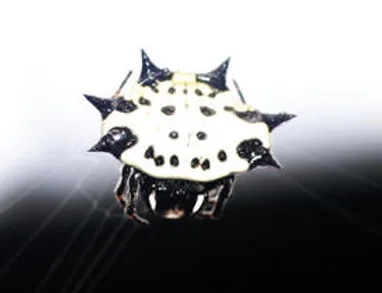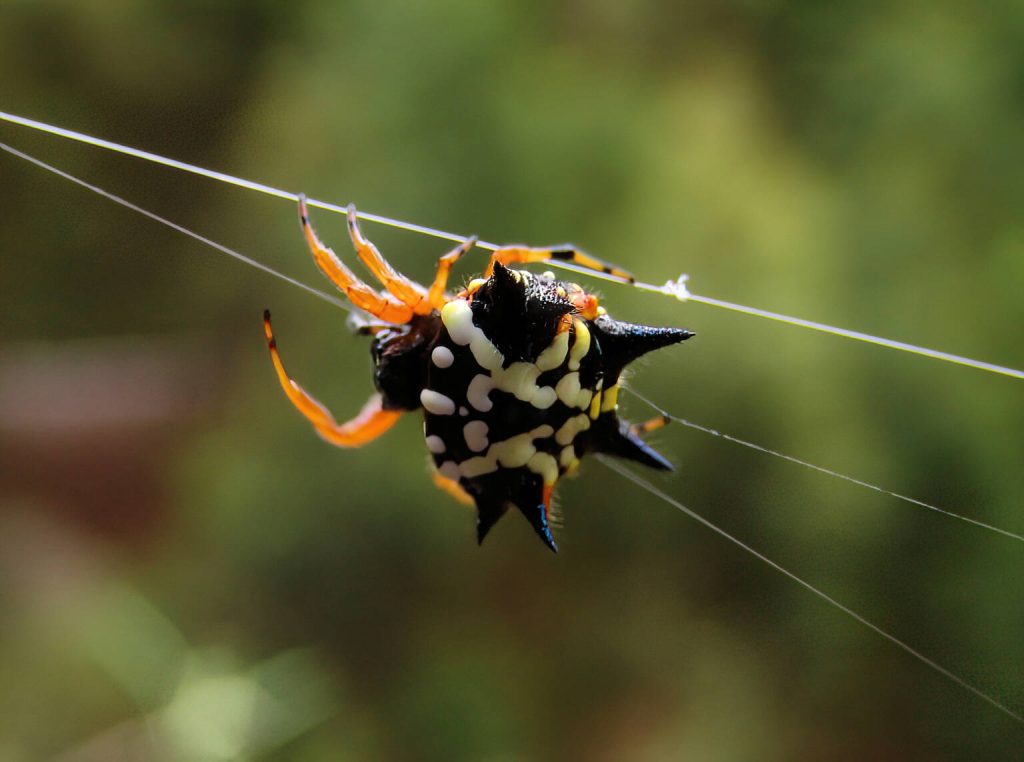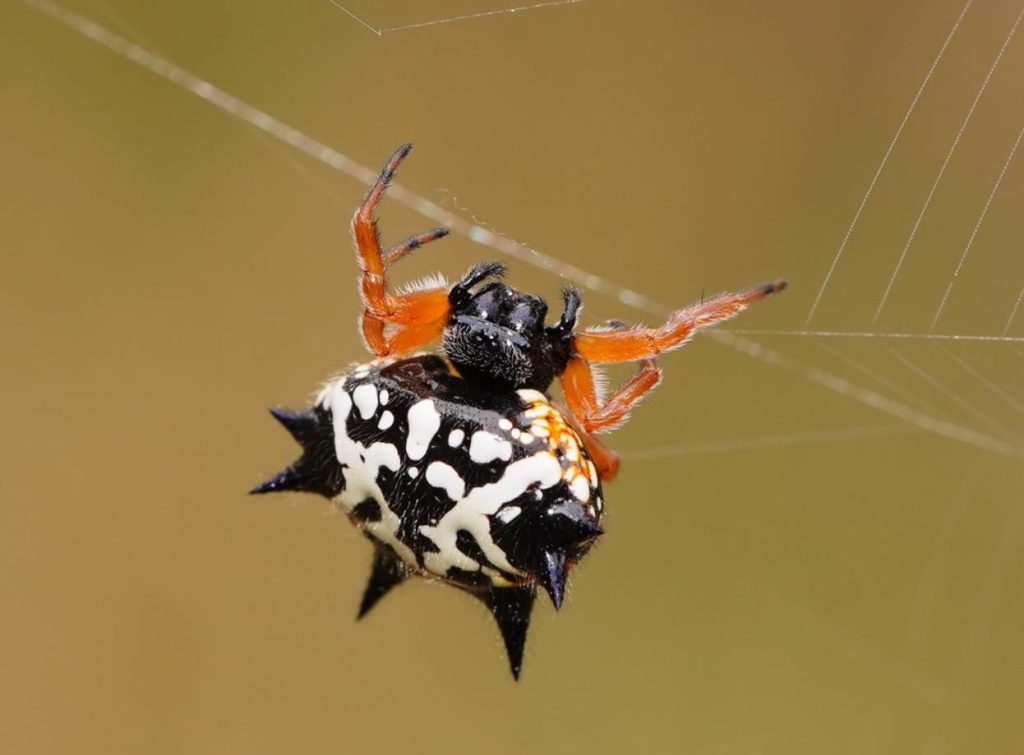
The Jewelled Spider is also known by its Latin name – Gasteracantha Minax, meaning “threatening and projecting”. They are also known as spiny orb weavers and are part of the orb weaving spider family. This spider’s body is very broad and grows to the size of a 20c piece, with its 8 legs being the length of a pin (fairly short for a spider). Its abdomen is strikingly coloured with bright yellow and white and black. Six stout spines (long and sharp) come from the border of the abdomen.
Habitat:
These spiders mostly can be found in tropical and subtropical regions of the world including Australia. In Australia, this Jewelled Spider has been found in all states including Tasmania and on numerous islands off the coast. It is particularly common in the Summer months of January and February. These spiders inhabit mostly shrub areas close to swamps and creeks. Many Jewelled Spiders are solitary but the well known Christmas Spiders are frequently found in colonies of communal webs which may number hundreds and even thousands. These large colonies overlap one another among shrubbery in the bushland.
Prey:
Jewelled Spiders spin a fine circular web (wheel-like) to snare their prey. Their webs often overlap and are usually built a metre or two from the ground. Their prey includes flying insects especially flies and communities of these spiders are very social in that they share their prey no matter whose web it lands on.

Like most spiders, the Jewelled Spider mates, the female eats the males, the female lays eggs, the eggs hatch and the young spiders are on their own from hatching. Sometimes they are carried away from the web by the wind.
Venom:
Jewelled Spiders have a bite that gives a mild local pain. They are harmless to humans and usually move out of the way when approached. If bitten, the victim (fly) would be paralysed then snared in the web.
The female is the stronger of the breed and her bite is more intense. If bitten by a Jewelled Spider, a human may experience localized pain and swelling. He/she should apply a cold compress or ice to the area. If swelling or pain does not subside, he/she should seek medical advice in case of allergy.
Conclusion:
The spikes of the Jewelled Spiders are their most distinguishing feature. These would help to frighten their prey and are also used in their defence to avoid becoming prey for other animals.
Austracantha is a genus of spider with a single species, Austracantha minax, commonly known as the jewel spider or the Christmas spider. It is a member of the family Araneidae (the orb-weavers) and is endemic to Australia. They are relatively small spiders, reaching a maximum total body length of only around 12 mm (0.47 in) for females, and 5 mm (0.20 in) for males. Their abdomen has six distinctive projections (“spines”) that makes them easy to identify. They are predominantly a shiny black, with variable white, yellow, and orange patterns. Melanistic forms also occur during autumn. They are facultatively gregarious, and can be found in large aggregations of overlapping orb webs. They feed on small flying insects that get entangled in their webs. They are harmless to humans, though the webs can be a nuisance for bushwalkers. They are most abundant during the summer months.

Jewel Spider
The Christmas Spider is known by several other names, most commonly Jewel Spider but also as Six Spined Spider or Spiny Spider.
Females have bright yellow and white patterns with a ring of black spines. Melanic females have the same shape but may be completely black. Males have smaller spines and have a yellow, brown, white and black pattern. Six spines protrude from the sides and bottom end of the abdomen.
Size
Females are larger at 7 mm, males are 4 mm.
Behaviour
Diet
Opportunistic, insects.
Movement
Females sit in the middle of the web. Males can often be found in the vegetation around the perimeter of the web. Often in aggregations in which many webs are supporting each other.

Breeding
Eggs sacs are red-brown, and can be a variety of shapes. They are usually attached to a twig near the web.
The Jewel Spider also called a Spiny Spider or a Christmas Spider (Astracantha minax, previously Gasteracantha minax), is a medium-sized spider. The female is about 10 mm across its abdomen, and the male around 5 mm. It has 6 spines on its round, hard abdomen, giving it a crab-like appearance, and is very brightly coloured, with red legs. On its abdomen it has yellow and white spots on a black background. These spiders are said to rarely bite, and if they do, the poison normally only causes a localised reaction. Care should always be taken, especially for those who may have severe allergic reaction (anaphylaxis).
On interesting thing about the web of this Jewel Spider is that the spider seems ‘deliberately’ make the support silk lines visible. Their orb webs are invisible, or hard to be seen, as most other spider webs. However, for the anchor threads which support their webs, there are many white dots on the silk, about 20mm apart. There is an advantages to the web because the large animals, such as human, will see those silk lines and not accentually walk into and destroy the web.
